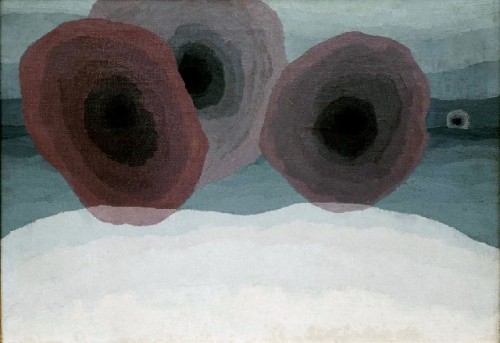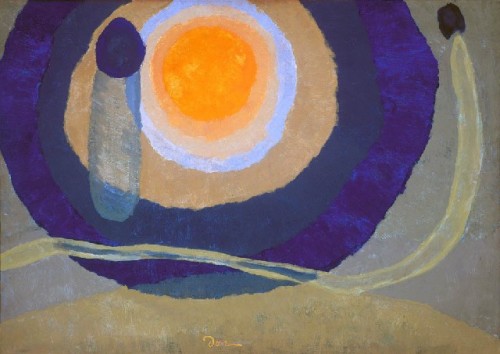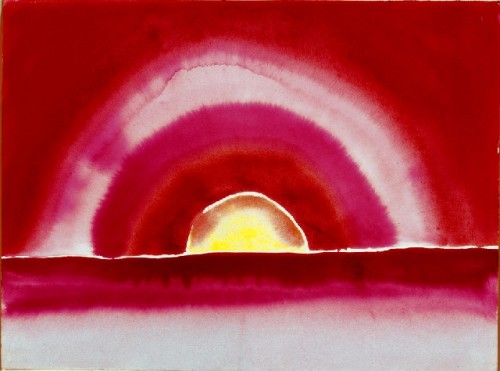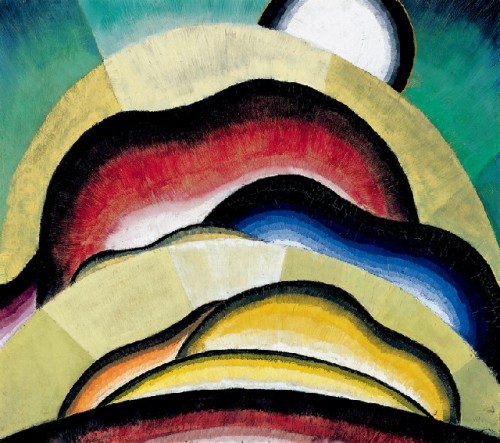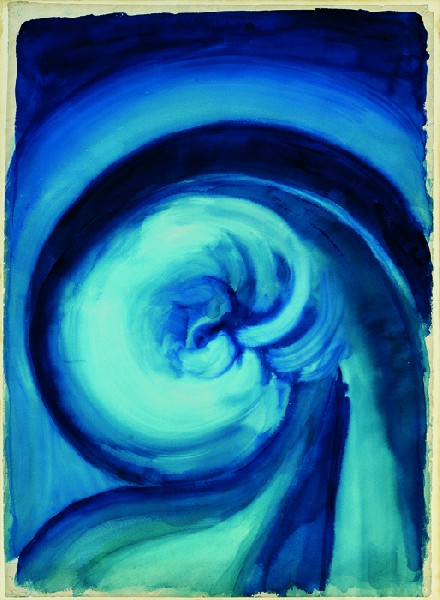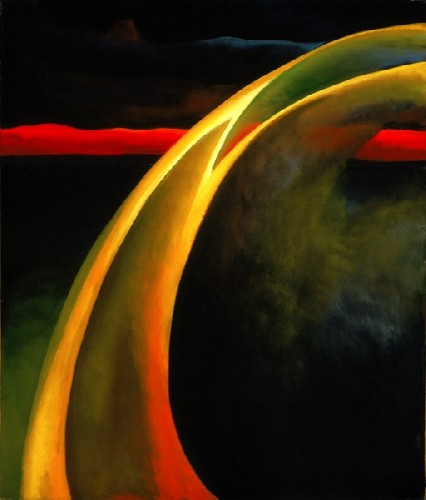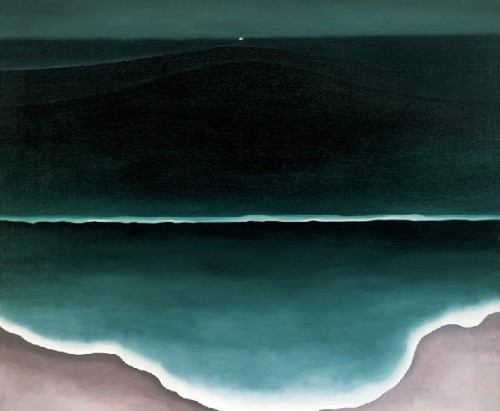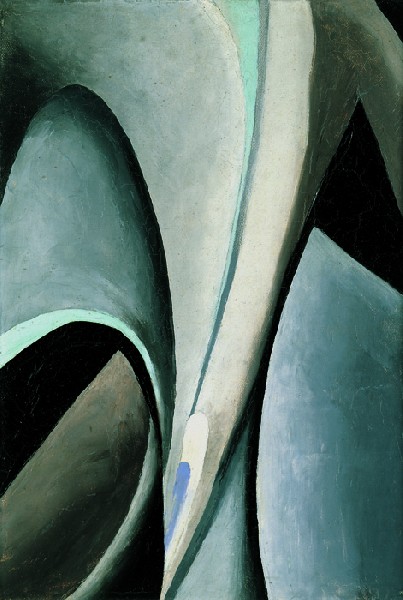Dove/ O'Keeffe Circles of Influence
Clark Art Institute Exhibition Through September 7
By: Charles Giuliano - Aug 22, 2009
Dove/ O'Keeffe Circles of Influence
Curated by Debra Bricker Balkan
Sterling and Francine Clark Art Institute
Williamstown, Mass.
June 7 through September 7, 2009
Catalogue: Debra Bricker Balkan with an introduction by Michael Conforti, 156 pages, Yale University Press, New Haven and London
The immensely popular, summer long exhibition at the Clark Art Institute "Dove/O'Keeffe Circles of Influence" will end on September 7. It is one of several outstanding exhibitions on view in Williamstown and North Adams making the Northern Berkshires a primary destination for the visual arts. The Williams College Museum of Art is showing "Prendergast in Italy" as well as a dense survey of photographs by Edward Steichen. Mass MoCA is featuring its first full season with the building of installations by the late Sol LeWitt.
There is an interesting synergy in this selection of special exhibitions. Of course there is a dialogue about how to promote and market visitors to the three museums. The intention is to make sure that the visitor who sees Sol LeWitt will take the time to seek out Dove/ OKeeffe, and Prendergast. Overtly that may seem like selling apples to an audience hungry for oranges. But the diversity and disparity is not as great as one might think.
It is not an accident, for example, that the Clark which is primarily noted for its depth in 19th century painting, is now edging into the early 20th century with Dove and O'Keeffe. Looking ahead to next summer, for example, the Clark will feature "Picasso Looks at Degas" from June 13 through September 12, 2010.
This is the execution of a strategy conveyed to me during an interview with Michael Conforti, the director of the Clark, several years ago. He was aware that museums could only rehash Monet and Renoir so many times. Lord knows they tried. It is a matter of going to the well too often before it runs dry. Conforti spoke of gradually raising the bar into modernism appealing more to the taste of younger audiences. Arguably for this ever younger museum audience O'Keeffe and Picasso are artists as marketable as Monet and Renoir.
Of course, the issue for the Clark is that its heart and soul is rooted in the art of the past. It can only push so far without losing contact with its base and mandate. Visitors fill the parking lot of the Clark for its Impressionists. But Conforti also has a shrewd sense of where the action is. If the museum has fared well with Dove/ O'Keeffe it should do as well if not better next season with Picasso/ Degas. Which, if you think about it, is a perfect match for the Clark. The museum has strength in Degas but does not own a major work by Picasso. Never say never.
The Clark has staked out real estate on the Mass MoCA campus. It has a long term lease on the building over which is the Mass MoCA logo. One passes it on the way to the main entrance of the museum. As of now no plans for the space have been revealed. But it would make sense that the building would emphasize Modernism as a transition between the Clark's 19th century collections and the cutting edge contemporary exhibitions of Mass MoCA. Consider, for example, if next summer for its Picasso/ Degas exhibition there was an increment hung in the Mass MoCA annex of the Clark. That would surely be a win win for both institutions. It would induce visitors to visit both museums.
In assessing the degree of difficulty of presenting Dove/ O'Keeffe one assumes that there was relatively little risk taking. There was surely no cry of outrage from the Clark's patrons and friends. It is interesting that gender has played a role. Everyone knows that O'Keeffe was the foremost woman artist of her generation. She was the only woman represented in the exclusive club of the American avant-garde that showed with the photographer/ gallerist/ publisher Alfred Steiglitz (1864-1946). O'Keeffe (1887-1986) married him in 1924 and outlived him, but never remarried, for another 64 years.
Initially gender worked against her in the struggle to become established during an era when there were few successful women artists. In more recent decades, with the rise of feminism, it has ensured her enormous status as an artist and innovator. While many art historians have attempted to retrofit her as a feminist she did not view herself in this manner. Her flowers have been discussed for their onic symbolism. She told interviewers that for her they were just flowers and she was interested in the forms and colors. This exhibition includes examples of that work.
The trope of this exhibition is that in the progressive and experimental nature of their work Dove and O'Keeffe were peers, colleagues, and friends who shared common impulses and influenced each other. The selection of works makes this point beyond question. It is the most compelling aspect of the project.
But the interesting question is why, if they were equals, that Dove is less widely known and appreciated than O'Keeffe? It is ironic that the fact that he is a male artist means that he did not get the special attention accorded to O'Keeffe. Not to take away any of her remarkable accomplishments. She very much saw her self as a peer with the other artists in the Stieglitz circle: Marsden Hartley, Charles Demuth, John Marin and Marius de Zayas as well as Dove. With Stuart Davis, John Covert, Patrick Henry Bruce, Max Weber, Stanton MacDonald Wright, Morgan Russell, Alfred Maurer, Joseph Stella, Charles Sheeler, Oscar Bluemer, and a handful of others, they fought the lonely and difficult battles of modern art in America. The Armory Show introduced the European avant-garde to America in 1913.
It was in Stieglitz's Gallery 291, so named for its address on Fifth Avenue, that O'Keeffe and other artists were exposed to European modernism from Rodin and Brancusi to Picasso. The gallery, during its tenure from 1905 to 1917, was the only place in New York to view advanced art. Stieglitz, who lived on a trust fund and paid stipends to his artists, was a notoriously poor businessman. Even O'Keeffe stated with some irony that it would have helped if he had sold one of her pictures now and then. He was selective about with whom he "placed" the work of artists he represented. You had to be somebody to qualify to buy what he showed. In that sense he was functioning more as a curator and propagandist than gallerist.
Stieglitz was also oddly protective of relationships with his stable of artists. When Duncan Phillips became devoted to collecting works by Dove he put the artist on a monthly stipend. The checks were sent to Steiglitz who forwarded them to Dove. The artist and patron met only by accident when visiting the gallery. Stieglitz made sure there was no direct communication.
He would operate two other spaces The Intimate Gallery and An American Place. Any prospect of selling work ended with the Stock Market Crash of 1929. This also marked the transition to a new generation of artists including Edward Hopper, the American Scene, Regionalism, American Abstract Artists (AAA), and the Social Realists.
The works seen in the Clark exhibition focus on the dialogue surrounding an American avant-garde particularly in the development of abstraction. Dove and O'Keeffe were aware of Picasso and Cubism but their work evolved along a different trajectory. Instead of trying to keep up with the school of Paris they drew inspiration directly from nature. They "abstracted" forms and colors. Most importantly they did not become American Cubists like Karl Knaths, Blanche Lazzell and Agnes Weinrich in Provincetown.
With her footing in New York, and as a part of the Stieglitz circle, O'Keeffe in a filmed interview discussed how she and her peers were struggling to "Write the great American play or novel." She decided to paint the Great American Picture which resulted in "Cow's Skull, Red, White and Blue" (1931) now in the collection of the Metropolitan Museum of Art. It reveals her interest in creating iconic images as she did when living in the South West near Taos, New Mexico. She struggled for the emblematic.
By contrast there is none of that impulse to create paradigmatic paintings in the oeuvre of Dove. This exhibition, however, reveals a focus and consistency with many modest, well crafted accomplishments. The selection of work in this exhibition seems skewed by the curator, Debra Bricker Balken, to place Dove and O'Keeffe on a level playing field. Since her best known works are not included this creates a false impression. There is far more range and depth to her work than what is revealed in this modestly scaled exhibition. It is also true that one gets a better sense of Dove through the Lane Collection of the Museum of Fine Arts, Boston, or the Phillips Collection, in Washington, D.C.
Within its modest scope, however, this is a nice sampler of their work. During this rainy, miserable summer the Clark has provided shelter from the storm.

